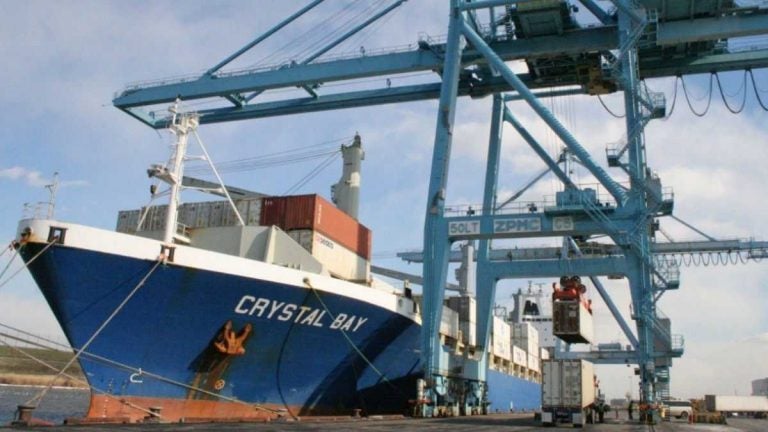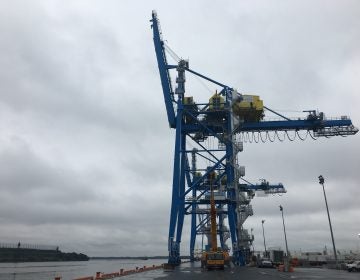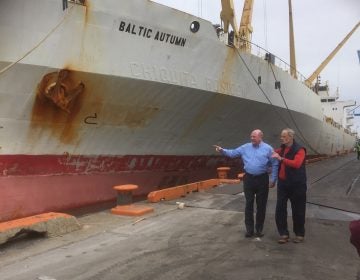Delaware reaches preliminary deal to lease Port of Wilmington
Delaware has made a preliminary agreement with the world’s largest independent, privately-owned port operator to invest more than $500 million in the Port of Wilmington.

The Port of Wilmington in Delaware. (Courtesy of Port of Wilmington)
The state of Delaware has made a preliminary agreement with the world’s largest independent, privately-owned port operator to invest more than $500 million in the Port of Wilmington over the next several years.
As part of the deal, United Arab Emirates-based Gulftainer would lease the Port of Wilmington from the state for 50 years. Gulftainer would build a new container shipping facility on the Delaware River, significantly expanding port jobs over the next decade while protecting existing positions, according to the state.
“The Port of Wilmington is an incredibly important employment center,” said Gov. John Carney, D-Delaware. “It provides good paying jobs for thousands of Delawareans, many of whom live around the city of Wilmington, many of those are individuals without college education. Those kinds of jobs that pay a livable wage without advanced degrees are few and far between these days.”
“In order for the Port of Wilmington to continue to be viable, we need to make capital investments to protect and preserve the facilities at the port, and develop a new container terminal at the former DuPont Edge Moor site, because international maritime trade is moving into containers, and we need a new container terminal to be competitive in that business. So, this will protect thousands of jobs, good paying jobs, and hopefully create many more.”
The port is the leading import site for bananas in North America, and it has the largest dock-side cold storage facility.
But as the port nears its maximum capacity, the Diamond State Port Corporation and the state say expansion is crucial to maintain its competitive edge, uphold the state’s economy and protect existing jobs—all while creating hundreds of new positions.
The proposal consists of two ship berths capable of holding much larger ships than the current port. The project would involve dredging a 45-foot access channel connecting the Edgemoor site to the main channel of the Delaware River.
For several years, the state has been searching for a public-private partnership for the project because it’s too costly for the state to fund alone.
In 2013, Kinder Morgan suspended its efforts towards a long-term lease agreement with the port. At the time, the Houston-based company blamed the leadership of one particular union for the breakdown in negotiations.
While the Kinder Morgan deal was in the works, the collective bargaining agreement for the International Longshoremen’s Association, Local 1694-1 was close to expiring. The company was reluctant to enter into any agreement with the state without first establishing a long term labor agreement.
“I think this time around, the RFP process was shepherded by [Secretary of State] Jeff Bullock, who’s the president of the Port of Wilmington board, and he’s done a tremendous job keeping all the stakeholders involved in the project, to involve them in the selection process, to make sure there are certain guarantees in the agreement to protect the labor that does the work at the existing port and into the future,” Carney said.
“And this has to be approved by the Delaware General Assembly, so it’s important the agreement contains assurances that provide comfort for members of the General Assembly.”
The Gulftainer Group currently operates 15 ports and logistics facilities all over the world, including the Port of Canaveral in Florida.
Under the preliminary agreement for a 50 year lease, Gulftainer’s subsidiary GT USA would make annual royalty payments to the state, reaching an estimated $13 million over the next decade.
The company also would invest more than $580 million in the port over the next nine years, which includes about $410 million for the new container facility at the Edgemoor site, which was acquired by the Diamond State Port Corporation in 2016. Construction would begin by 2022.
GT USA also would build a training facility at the site for port and logistics careers, with a goal of training 1,000 potential workers annually.
“We see enormous opportunity at the Port of Wilmington and are gratified by the support for GT’s plans from Delaware unions, business, and broader community,” said Gulftainer CEO Peter Richards in a statement.
“We want to restore the Port as an important national cargo gateway, doubling cargoes, doubling revenue to the state, investing hundreds of millions of dollars and adding thousands of workers over the next decade. We see only upside in the U.S. and the Port of Wilmington is poised to become one of the biggest success stories in the U.S. ports and logistics sector.”
The Board of Directors of the Diamond State Port Corporation and the General Assembly must approve terms of the agreement. The Board is scheduled to deliberate on the agreement on April 6. If approved, the agreement will be sent to the Joint Committee on Capital Improvement of the General Assembly.
“All of us are focused on seeing the state’s investment in Edgemoor pay off,” said state Sen. David Sokola, D-Newark, who co-chairs the Joint Committee on Capital Improvement and is a member of the DSPC Board of Directors, in a statement.
“The former DuPont site is the right location – with pre-existing rail and highway links in one of the nation’s most strategic areas – and Gulftainer may turn out to be just the right investor to transform it into a global shipping destination and a major asset for Delaware’s economy. I hope to review a finalized proposal in our board meeting next week and, if it is the right deal for Delaware, I look forward to supporting the plan in the Senate.”
WHYY is your source for fact-based, in-depth journalism and information. As a nonprofit organization, we rely on financial support from readers like you. Please give today.





